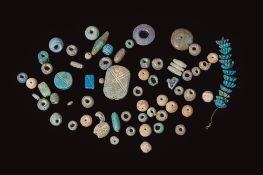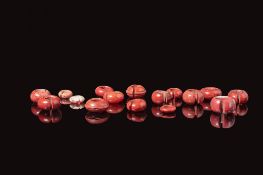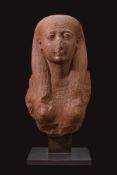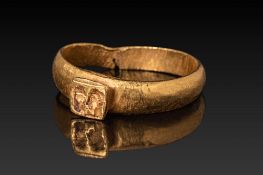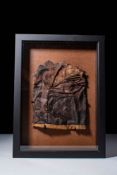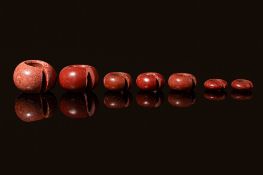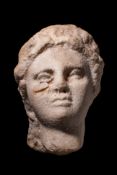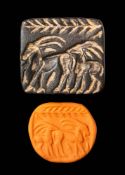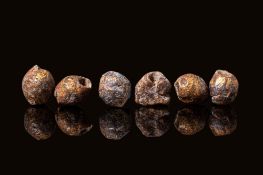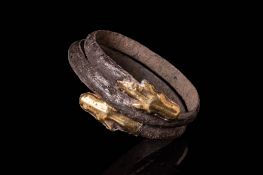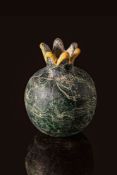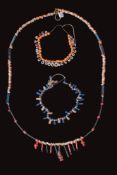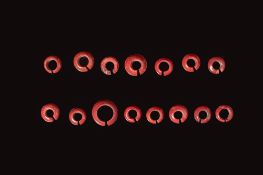Ca. AD 400 - 600. A bronze ring with a broad oval bezel engraved with a five-pointed star formed by intersecting linear strokes. The star is encl...
*
Sortieren nach:
- Auktionshaus
- Liste
- Galerie
-
909 Los(e)/Seite
Ca. 100 BC - AD 100. A silver ring with a bezel formed by two confronting snakes, each rendered with a raised almond-shaped head. Between the hea...
Ca. AD 300 - 500. A greenish glass infundibulum with a globular body and a tall, cylindrical neck expanding into a broad, funnel-shaped mouth. A s...
Ca. 400 - 300 BC. A wheel-made terracotta guttus with a flattened, globular body on a ring foot, a vertical strap handle, and a flaring spout. Th...
Ca. AD 1200 - 1400. A bronze ring with a flat bezel engraved with a Holy Dove in profile, its wings extended and head lowered. The bezel is enclo...
Julio-Claudian Period, Ca. 27 BC - 68 AD. A marble head of a youthful male with idealised features. Notice that the sculptor presents this individ...
Ca. 600 BC. A silver ring with a flat circular bezel engraved with a cross surrounded by a Greek inscription arranged in a radial pattern. The ho...
New Kingdom, Ca. 1550 - 1069 BC. A collection of amulets, pendants, and beads in faience and glass, including a faience hedgehog scaraboid with d...
ATTIC KYLIX WITH PALMETTES
Ca. 520 - 500 BC. A black-figured kylix with a shallow cup tapering towards the footed base. The vessel is equipped with slightly upturned handles...
Middle Kingdom, Ca. 2055 - 1790 BC. A faience cylinder seal and a steatite scarab. The seal is engraved with a standing figure, a stag, and a sty...
Ca. 1200 - 900 BC. A pair of bronze bracelets, both with a solid, rounded profile and an open-ended, penannular form. The bracelet on the left ha...
Ca. AD 1550 - 1650 . A pair of textile inlays cut into five-sided panels, each finely woven with a densely patterned battlefield scene. The compos...
Third Intermediate Period, Ca. 1069 - 664 BC. A collection of faience beads in a variety of shapes, including ring-shaped, spherical, cylindrical...
CELTIC SILVER RITUAL MASK
Ca. 100 - 1 BC. A silver mask of elongated form with incised and repoussé facial features, including a pronounced linear nasal ridge, a rectangul...
Late Period to Ptolemaic Period, Ca. 664 - 30 BC. A group of 16 penannular rings of varying diameter and thickness, each formed as a circular ban...
NEO-ASSYRIAN GOLD PAZUZU PENDANT
Ca. 800 - 600 BC. A gold amulet in the form of the head of the demon god Pazuzu, depicted with exaggerated facial features and a fierce expressio...
Ca. AD 400 - 600. A silver ring with a raised, oval-shaped bezel engraved with a monogram formed from intersecting letters, including a central '...
Ca. 500 BC. A bronze double-headed hammer with an S-shaped form, each end terminating in an opposite beast-shaped head, one facing upward and the...
New Kingdom, 19th Dynasty, Reign of Sety I or early years of Ramesses II, Ca. 1290 - 1270 BC. A red granite bust depicting a goddess, shown weari...
New Kingdom, Ca. 1550 - 1069 BC. A wooden bust of a pharaoh. The face is solemn, with almond-shaped eyes, a defined nose, and full lips that conve...
Ca. 450 - 400 BC. A terracotta kylix with a broad shallow bowl, a sharply offset rim, and a low ring foot. The interior is decorated with central...
Ca. 3000 - 2500 BC. An amulet of white marble. The shape is a crescent with a bar raising from the centre of the inside of the crescent. There is ...
BYZANTINE GOLD MARRIAGE RING
Ca. AD 500 - 600. A gold ring with a flat-section hoop, widening slightly at the shoulders and set with a square bezel engraved in relief with th...
EGYPTIAN SCHIST PALETTE
Predynastic Period, Ca. 3600 - 3100 BC. A rectangular palette carved from dark grey schist with slightly rounded corners and smooth, flat surface...
Ca. 400 - 200 BC. A carved quartzite head of a female, with a rounded face, prominent cheekbones, and a slightly parted mouth. The eyes are almon...
Ca. 332 - AD 200. A collection of faience amulets and fragments, including representations of deities, animals, and symbolic motifs, as well as f...
BYZANTINE BRONZE CROSS PENDANT
Ca. AD 1000 - 1200. A cast bronze pendant in the form of a cross with slightly flared arms and an integral suspension loop above. The front is de...
Ca. 600 - 300 BC. A collection of three restrung necklaces. The uppermost necklace consists of multicoloured small disc beads interspersed with s...
BYZANTINE BRONZE CROSS PENDANT
Ca. AD 600 - 800. A bronze cross pendant of flat, broad-armed form with expanded rounded terminals. Each arm is decorated on one side with punche...
EGYPTIAN LEATHER HAT
Roman Period, Ca. 30 BC - AD 200. A leather hat of cylindrical form, made from stitched panels with a prominent central ridge and a reinforced lo...
Ca. AD 1 - 300. A cast silver pendant depicting an eagle in a standing posture, with a small head and wings folded against the body. The figure i...
FINE BACTRIAN SCHIST BOWL
Ca. 3000 - 2000 BC. A schist bowl with a corseted body and a broad opening. The upper section has a smooth, unadorned surface, while the lower po...
Ca. AD 900 - 1100 . A silver-gilt pyxis with a cylindrical body and a domed lid. The exterior is decorated with a combination of gilded and niell...
Ca. AD 1 - 150. A dark red intaglio engraved with the profile bust of a noblewoman facing left. Her hair is styled in waved sections drawn back b...
Ca. 1550 - 332 BC. A pair of restrung necklaces. The one on the outside is composed of small annular beads in red, white, black, and beige. The o...
New Kingdom, Ca. 1550 - 1069 BC. A collection of four scaraboid frog amulets and one scarab, each pierced lengthwise through the base and engraved...
Ca. AD 600. A gold ring with a circular bezel engraved with a spread-winged eagle shown in frontal pose, head turned to its right, with granulated...
Late Period to Ptolemaic Period, Ca. 664 - 30 BC. A group of seven penannular rings of varying diameter and thickness, each formed as a circular ...
Ca. AD 1000 - 1200. A silver-gilt deep cup with a bulbous lower portion, a rounded shoulder, and a tapering profile leading to a pronounced rim. ...
Ca. 300 - 100 BC. A marble head of Aphrodite with a softly rounded face. Her hair is styled in thick, wavy locks, and drawn back into a low chigno...
Ca. AD 800 - 1200. A broad silver archer’s ring with sharply tapering sides, the exterior engraved with a stylised motif flanked by narrow panels...
Ca. 1500 BC. A black stone seal engraved with a procession of two horned animals walking left, both depicted with elongated limbs and curved, deep...
Ca. 1600 BC. An alabaster palette carved in the form of a stylised duck, with a rounded, hollowed interior and an arched neck curving forward int...
New Kingdom, Ca. 1550 - 1069 BC. A collection of five faience pendants in varying shades of turquoise and blue. From left to right: a djed-pillar...
Ca. AD 300. A matched pair of gold earrings, each composed of a round-section hoop embellished with a crescent-shaped element with inward-scrolle...
Ca. AD 1 - 300. A collection of three glass neck fragments from unguentaria. The first, on the left, is made of dark blue glass with a tall cylind...
Ca. 30 BC - AD 100. A faience unguentarium with a short, cylindrical neck and a tapering ovoid body, decorated around the shoulder with applied el...
EGYPTIAN QUARTZ RITUAL ROD
Ca. 1550 - 664 BC. A long rod carved from translucent quartz, tapering gradually to a pointed end. The opposite end is rounded and bulbous, formi...
IRON AGE LONG SWORD
Ca. 500 BC. A long iron sword with a narrow blade of near-parallel edges, tapering to a sharply defined point. The base of the blade leads into a...
New Kingdom, Ca. 1550 - 1069 BC. A pair of faience pendants in turquoise-green glaze. The pendant on the left is modelled as a cluster of grapes,...
New Kingdom to Ptolemaic Period, Ca. 1550 - 30 BC. A collection of amulets in faience, steatite, and various stones. The assemblage includes nume...
Ca. 100 BC - AD 200. A collection of glass beads with applied gold leaf, comprising cylindrical, globular, and composite forms. The assemblage in...
Egypt or Eastern Mediterranean, Ca. 4th century AD. A pair of olive green glass amphoriskoi, each with dark bluish-green handles and trail, both ...
Ptolemaic Period to Roman period, Ca. 332 BC - AD 200. A collection of six glass globular beads with traces of gold leaf. Perforated longitudinal...
EARLY BYZANTINE GOLD PENDANT
Ca. AD 600 - 700. An almond-shaped gold pendant with openwork decoration in opus interrasile, framed by a raised border and embellished with a sy...
Ca. AD 300 - 600. A pale green translucent glass dish with a star-shaped form, featuring eleven evenly spaced rounded points extending from the b...
Ca. 100 BC - AD 200. A bracelet formed from a single rod of bronze coiled into two overlapping turns, the terminals cast in the form of confronti...
New Kingdom, Dynasty 18th - 19th, Ca. 1550 - 1190 BC. A glass pomegranate votive vessel with a globular dark green body marbled with lighter vein...
Late Period, Ca. 664 - 332 BC. A collection of three restrung strands of glass and faience beads. The longest strand consists of annular beige be...
Late Period to Ptolemaic Period, Ca. 664 - 30 BC. A group of 15 penannular rings of varying diameter and thickness, each formed as a circular ban...














